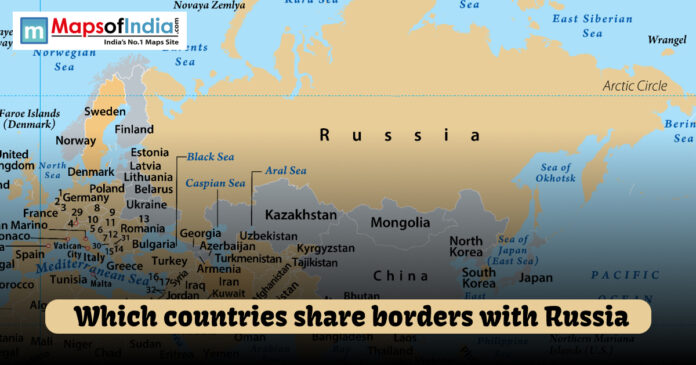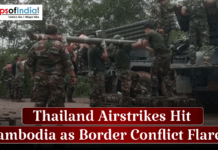Russia is the largest nation on the globe based on its land area, covering Pacific Asia and Eastern Europe. Being one of the largest countries in terms of size, it is a land-boundary country to a lot of states, and thus, it forms an important geopolitical player both in Europe and Asia. Knowing the countries that border Russia not only provides details of geography but also provides a background of the political, economic and security interaction that Russia has with other countries of the world.
Throughout the history of states, the boundaries of their territories have changed many times; nowadays, there are lots of borders between any two countries, but the border with Russia is of particular importance due to its unique land borders. Therefore, in this blog, we will examine all the countries with a land border with Russia by continent and briefly comment on what these borders are.
Overview: How Many Countries Border Russia?
Russia shares land borders with 14 countries. This has made it become one of the countries that have the most number of neighbours in the world besides China (14) when the sea boundaries are not considered, in par with Brazil (10) and Germany (9).
European Neighbors of Russia
Russia covers most of Eastern Europe, and it borders various countries on the European continent. These include:
1. Norway
- Border Length: ~191 km
- Significance: There is a short and strategic border between Russia and Norway in the Arctic Circle. This region is significant in regard to sources of energy and military installations.
2. Finland
- Border Length: ~1,340 km
- Significance: It is among the longest borders of Russia between it and the European nations. This border acquired a new geopolitical significance after Finland joined NATO in 2023.
3. Estonia
- Border Length: ~324 km
- Significance: Estonia is a former Soviet state of Soviets; it is a member of the European Union and NATO. The frontier Russia-Estonia is one of the hot spots in the relations of the EU and Russia.
4. Latvia
- Border Length: ~332 km
- Significance: Similar to Estonia, Latvia is also a Baltic nation and a member of NATO. The frontier is tightly patrolled, and it is usually a tense one.
5. Lithuania (via Kaliningrad)
- Border Length: ~261 km (shared with Kaliningrad exclave)
- Significance: Kaliningrad, being a Russian Exclave, has Lithuania at its southern border. The strategic importance of this region is that it is near NATO States.
6. Poland (via Kaliningrad)
- Border Length: ~210 km
- Significance: Poland, similar to Lithuania, shares a border with Kaliningrad, and this is an area where both Russia and NATO have given military attention.
7. Belarus
- Border Length: ~1,312 km
- Significance: Belarus is the closest ally of Russia. Both countries are highly united by military, economic, and political relations.
8. Ukraine
- Border Length: ~1,974 km (disputed in parts)
- Significance: This border turned out to be one of the most conflictual borders of the world, ever since it has been at war since 2014, and the war has intensified in 2022. Some segments of the border have fallen under the seizures of Russian forces, most notably in Crimea and the Eastern part of Ukraine.
Asian Neighbors of Russia
The Russian Asian border is even larger because it crosses thousands of kilometres of huge and usually poorly populated land. These include:
9. Georgia
- Border Length: ~894 km
- Significance: Russia also has a poor association with Georgia, especially after a war occurred in the year 2008, which occurred due to the South Ossetia and Abkhazia territories, which were declared by Georgia and supported by Russia.
10. Azerbaijan
- Border Length: ~338 km
- Significance: The Russia-Azerbaijan border is a part of the Caucasus, which is abundant in oil and gas reserves and has intricate ethnic backgrounds.
11. Kazakhstan
- Border Length: ~7,644 km
- Significance: This is the longest international border of Russia and one of the longest on earth. Kazakhstan is Russia’s major ally and trade partner, and both are members of the Eurasian Economic Union.
12. China
- Border Length: ~4,209 km
- Significance: The Russia-China border has been problematic in the past, but it is currently peaceful and economically worthwhile. The two have been enhancing their relations over the past years based on trade, defence, and energy.
13. Mongolia
- Border Length: ~3,452 km
- Significance: Mongolia acts as a buffer between the two neighbouring countries of Russia and China. The general relationship with Russia is good, and there are historical and cultural relationships in which commonality is shared.
14. North Korea
- Border Length: ~18 km
- Significance: It is the shortest land border that Russia has with any other country. Though small, this border permits some ways of trade and communication between Russia and North Korea.
What About Maritime Borders?
Russia also have maritime boundaries with:
- Japan (through the East Sea and the disputed Kuril Islands)
- United States (through the Bering Strait)
These maritime borders will only further emphasise Russia’s strategic geo-strategic position between Europe, Asia and the Pacific.
Geopolitical Importance of Russia’s Borders
The large size of Russia poses a problem because Russia has to deal with an array of political regimes, cultures, and unions. In short:
- NATO Presence: Russia shares a border with five nations that are part of NATO, and this affects its military policies.
- Energy Corridors: Europe and Asia Pipelines are very common to run through or in the vicinity of the border area.
- Border Conflicts: The situation with Ukraine, Georgia, and the Baltic states has not been solved yet.
- Cultural Ties: A common history between the former Soviet states tends to have currency in border relations.
Conclusion
The land borders of Russia span continents and geographies, from icy plains of the Arctic to the mountain country of the Caucasus and steppes of Central Asia. Every neighbouring state is significant in its way when it comes to influencing the role of Russia in the world. As a student of geopolitics, a traveller of curious nature, or a student who tries to familiarise himself with the geography of the world, knowing these frontiers can help demystify the far-reaching and complicated influence of Russia.
With the world events going on in the world, particularly in Eastern Europe and Asia, such boundaries will form the centre points in relation to matters of security, trade and diplomacy in the future.




